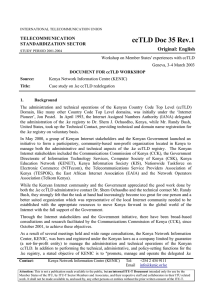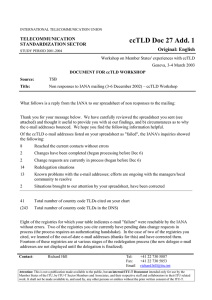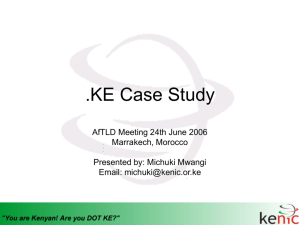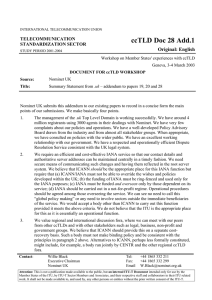ccTLD Doc 35 Original: English TELECOMMUNICATION STANDARDIZATION SECTOR
advertisement
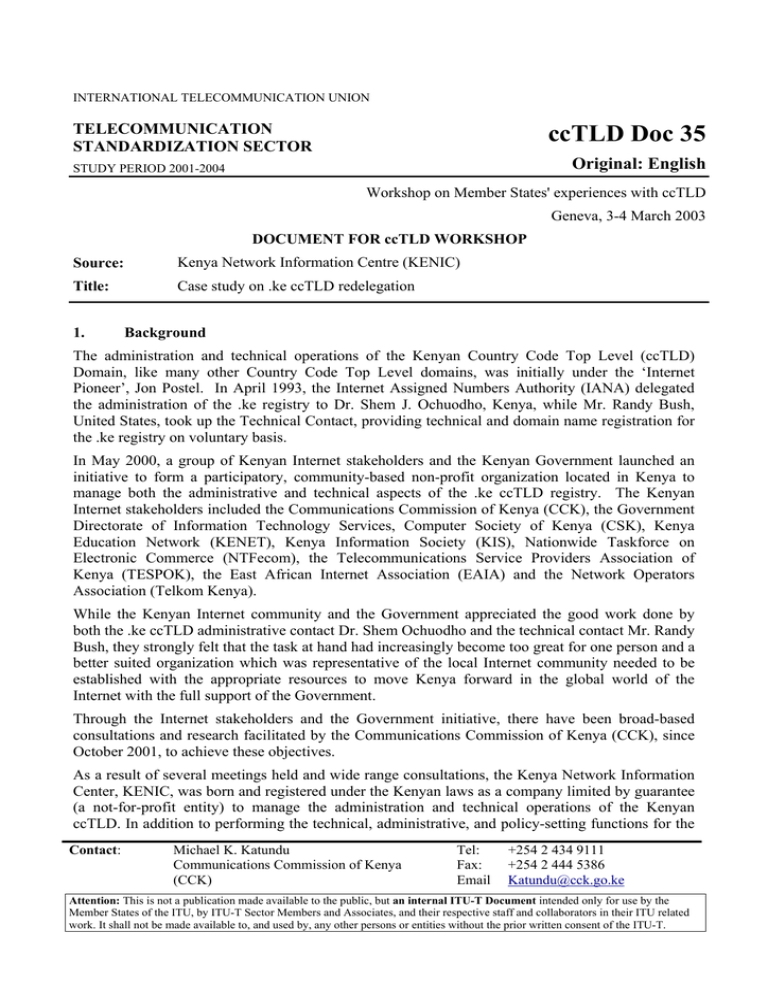
INTERNATIONAL TELECOMMUNICATION UNION TELECOMMUNICATION STANDARDIZATION SECTOR ccTLD Doc 35 Original: English STUDY PERIOD 2001-2004 Workshop on Member States' experiences with ccTLD Geneva, 3-4 March 2003 DOCUMENT FOR ccTLD WORKSHOP Source: Kenya Network Information Centre (KENIC) Title: Case study on .ke ccTLD redelegation 1. Background The administration and technical operations of the Kenyan Country Code Top Level (ccTLD) Domain, like many other Country Code Top Level domains, was initially under the ‘Internet Pioneer’, Jon Postel. In April 1993, the Internet Assigned Numbers Authority (IANA) delegated the administration of the .ke registry to Dr. Shem J. Ochuodho, Kenya, while Mr. Randy Bush, United States, took up the Technical Contact, providing technical and domain name registration for the .ke registry on voluntary basis. In May 2000, a group of Kenyan Internet stakeholders and the Kenyan Government launched an initiative to form a participatory, community-based non-profit organization located in Kenya to manage both the administrative and technical aspects of the .ke ccTLD registry. The Kenyan Internet stakeholders included the Communications Commission of Kenya (CCK), the Government Directorate of Information Technology Services, Computer Society of Kenya (CSK), Kenya Education Network (KENET), Kenya Information Society (KIS), Nationwide Taskforce on Electronic Commerce (NTFecom), the Telecommunications Service Providers Association of Kenya (TESPOK), the East African Internet Association (EAIA) and the Network Operators Association (Telkom Kenya). While the Kenyan Internet community and the Government appreciated the good work done by both the .ke ccTLD administrative contact Dr. Shem Ochuodho and the technical contact Mr. Randy Bush, they strongly felt that the task at hand had increasingly become too great for one person and a better suited organization which was representative of the local Internet community needed to be established with the appropriate resources to move Kenya forward in the global world of the Internet with the full support of the Government. Through the Internet stakeholders and the Government initiative, there have been broad-based consultations and research facilitated by the Communications Commission of Kenya (CCK), since October 2001, to achieve these objectives. As a result of several meetings held and wide range consultations, the Kenya Network Information Center, KENIC, was born and registered under the Kenyan laws as a company limited by guarantee (a not-for-profit entity) to manage the administration and technical operations of the Kenyan ccTLD. In addition to performing the technical, administrative, and policy-setting functions for the Contact: Michael K. Katundu Communications Commission of Kenya (CCK) Tel: Fax: Email +254 2 434 9111 +254 2 444 5386 Katundu@cck.go.ke Attention: This is not a publication made available to the public, but an internal ITU-T Document intended only for use by the Member States of the ITU, by ITU-T Sector Members and Associates, and their respective staff and collaborators in their ITU related work. It shall not be made available to, and used by, any other persons or entities without the prior written consent of the ITU-T. -2ccTLD Doc 35-E .ke registry, a stated objective of KENIC is to "promote, manage and operate the delegated .ke ccTLD in the interest of the Kenyan Internet community and being mindful of the global Internet community interest in consistent with Internet Corporation for Assigned Numbers and Names (ICANN) policies." 2. The Re-delegation process With an aim to engage Dr. Ochuodho in the process, the KENIC members regularly and repeatedly invited him to participate in their initiative. He was invited to participate in organizational meetings of the Steering Committee, to observe or speak at KENIC's open community forums, to communicate his concerns or suggestions via e-mail, and to join the board of directors of KENIC. Dr. Ochuodho declined to respond to all these invitations, and did not attend any of KENIC's organizational meetings or open community forums. The KENIC organizers regularly sent Dr. Ochuodho updates on their activities and minutes of meetings and included him on their mailing lists, in the hope that he might choose to participate or otherwise engage in dialogue toward the creation of a stable institutional home in Kenya for the .ke registry. On 9 June 2002, KENIC representatives contacted the IANA to formally request redelegation of the .ke ccTLD from the current administrative contact to KENIC and IANA forwarded the KENIC request to Dr. Ochuodho, as the current administrative contact, for his review and comment. On 10 July 2002, Dr. Ochuodho responded to the IANA that his host Internet Service Provider (ISP), African Regional Centre for Computing (ARCC), was hoping to upgrade its servers, in order to assume responsibility for the .ke technical functions as well. He further stated that "no ISP or KENIC has drawn our attention to any substantial problems with current arrangement." In view of Dr. Ochuodho's apparent failure to respond to or undertake any discussions with the KENIC members, the IANA sought to promote dialogue among the parties. After several inquiries by the IANA, Dr. Ochuodho met with the ICANN/IANA representatives, including the CEO and President of ICANN and the ICANN’s Counsel for International Legal Affairs, at the East Africa Internet Forum (EAIF), held in Nairobi on the 6th to 8th August 2002. At the EAIF meeting, Dr. Ochuodho acknowledged that he had been less than responsive to the Kenyan Internet community over the previous years, but noted that he had been kept extremely busy by his other important responsibilities, especially as a member of the Kenyan parliament. In response to the KENIC redelegation request, Dr. Ochuodho expressed his concerns with the KENIC process and organization, including his feeling that the redelegation was politically motivated. In response, the IANA representatives pointed out that a ccTLD administrative contact serves as a trustee on behalf of, and in service to, the local Internet community. As a trustee, the administrative contact must act fairly and in the best interests of the entire local Internet community, be responsive to the members of that community, and engage in dialogue about issues relating to the ccTLD. Dr. Ochuodho stated that he accepted these responsibilities, and agreed to undertake direct dialogue with the KENIC members in an effort to resolve his concerns and to attempt to reach a mutually acceptable set of management arrangements for the .ke ccTLD. In any event, Dr. Ochuodho agreed to report to the IANA on the results of those discussions within 30 days in which he would either: (a) work out a solution with KENIC on the management of the .ke ccTLD; (b) demonstrate significant support within the Kenyan Internet community for administration of the .ke ccTLD by him rather than KENIC; or (c) agree to the redelegation of the .ke ccTLD. The IANA sent a follow-up e-mail to Dr. Ochuodho reiterating these commitments and noting that in the event that neither (a) or (b) occurred within the set 30 days, the IANA intended to proceed with the redelegation according to its laid down procedures. However, Dr. Ochuodho did not -3ccTLD Doc 35-E respond to that e-mail. Indeed, the IANA has not received any direct communications from Dr. Ochuodho since that meeting. 3. Government and Member Support On 18 October 2002, the Permanent Secretary of Kenyan government's Ministry of Transport and Communications wrote to ICANN's CEO and President to reiterate the Kenyan government's recognition of KENIC "as the appropriate entity to hold the delegation of authority by the ICANN for administrative authority of the .ke country code top level domain (ccTLD)." The Permanent Secretary stated the commitment of the Kenyan government to fulfill its responsibilities as envisioned in the "Principles for the Delegation and Administration of Country Code Top Level Domains" adopted by ICANN's Governmental Advisory Committee (GAC) on 23 February 2000. The Kenyan government detailed out its role and responsibilities to KENIC and would "require that KENIC Limited manage the .ke top-level domain according to the interest of the Kenyan public and particularly its Internet community." The Kenyan government also endorsed the standard ICANNccTLD contractual mechanisms for redelegation and the designation of a successor registry operator, a set of anticipated policy coordination practices designed to minimize the likelihood of conflict between governmental and global policy requirements. To get off the ground, KENIC has relied upon contributions from its various members and supporters. TESPOK pledged to contribute engineering talent to establish KENIC's technical operations, and to provide a dedicated link between KENIC and the Kenyan Internet Exchange Point (KIXP). Telkom Kenya committed to supply two independent upstream links to the global Internet, while the Communications Commission of Kenya pledged an initial allocation of 10 million Kenyan shillings (approximately US $110,000) to fund the start-up of KENIC. 4. Summary Based on the circumstances described above, the IANA concluded that redelegation was warranted in this case despite the objections of the then administrative contact. Under IANA policy, primarily two yardsticks measure ccTLD redelegation requests: technical competence and the views of the local Internet community. In the case of .ke, the overwhelming consensus of the views that were expressed to the IANA is that KENIC had won the support of a wide range of Kenyan Internet stakeholders, including Internet Service Providers, users (academic, non-commercial, and business), and the government. Consistent with longstanding IANA policy, the IANA also gave significant weight to the views of the Kenyan government, which had expressed its confidence in KENIC as a community-based, open, participatory, non-governmental administrator for the .ke registry. In December 2002, KENIC was delegated as the .ke registry Manager and Administrative contact. Mr. Randy Bush was maintained as the technical contact until such a time when KENIC would complete the establishment of a competent technical operations to assume the technical operations of a registry and also to ensure a smooth transfer of the technical functions. However, Mr. Randy Bush in January 2003, without notice or consultation with the KENIC administration, declined to process any .ke registrations. Mr. Bush’s lack of transparency in the technical operations of ccTLDs put ICANN’s redelegation policies on the spotlight. However with the completion of the technical implementation, KENIC reinstated domain name registration services on 6th February 2003. More information on KENIC can be found at http://www.kenic.or.ke. ____________

